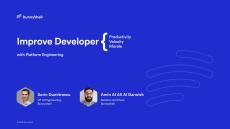- December 2024 (1)
- November 2024 (1)
- October 2024 (4)
- September 2024 (8)
- July 2024 (1)
- June 2024 (1)
- May 2024 (1)
- April 2024 (2)
- September 2023 (1)
- July 2023 (1)
- May 2023 (1)
- April 2023 (13)
Bunnyshell delivers real developer productivity by streamlining your development process with Internal Developer Platform, Preview Environments, and Standardized Development Environments.
Bunnyshell is a Environments as a Service platform that makes it incredibly easy to create and manage full-stack environments for development, staging and production, so your team can deliver software faster and focus on building great products. With Bunnyshell, you can create environments in your own cloud, from the simplest static websites to the most complex (microservices with many cloud-native dependencies) applications.
Free developers from time-consuming, unnecessary tasks that slow their work, so you and your team can focus on writing code:
- Automatic Preview Environments with every Pull-request: Accelerate review cycles, test changes deployed before merging, and make the development process a collaborative experience with preview environments for every code change.
- Preconfigured Dev Environment available on demand: Develop and debug locally while running environments remotely in the cloud, and see your changes live, precisely as they would look in production.
- On-demand Testing Environments with just one click: Whenever you need an environment for a release, a demo, or any sort of testing, create it, use it, then destroy it. You can easily control what data it receives and for how long it stays up. There's no need to pay for idle environments.
Do you want to ship 10x faster?





















